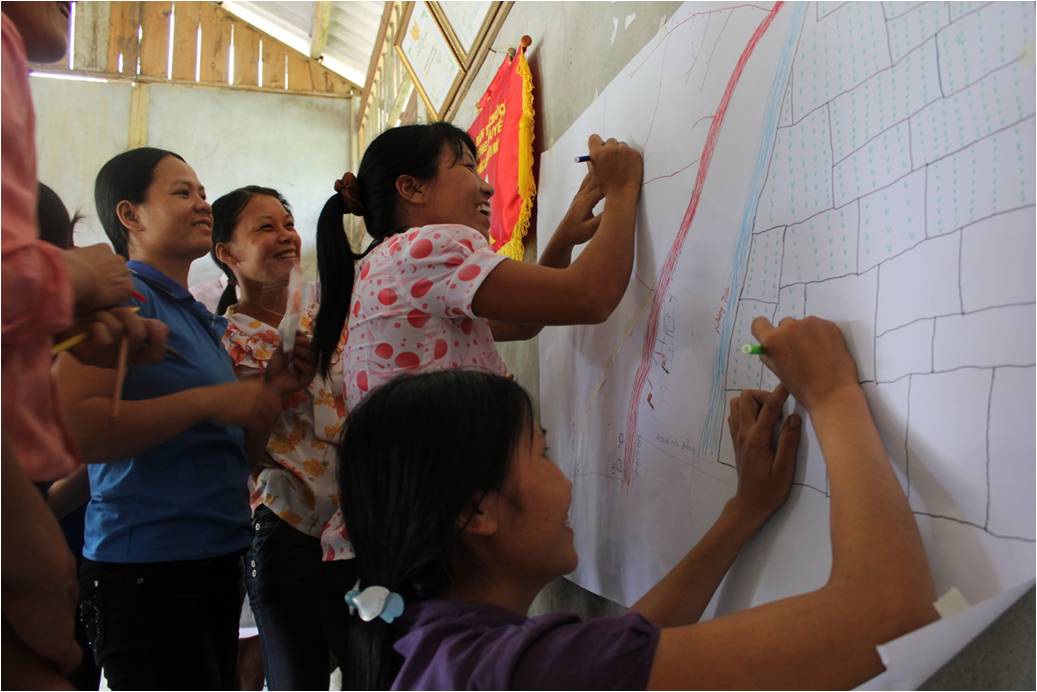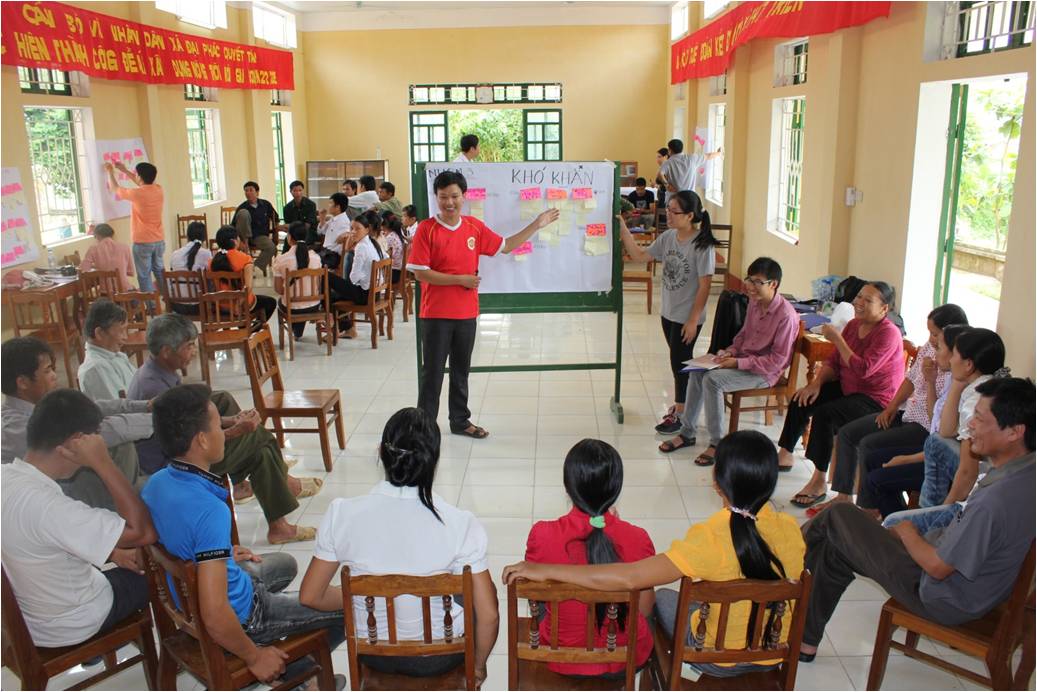A new perspective on adaptation prioritisation and costing in the Mekong region
A new perspective on adaptation prioritisation and costing in the Mekong region
Caitlin Peterson, Martin Ross, and Caitlin Corner-Dolloff from the International Center for Tropical Agriculture (CIAT) discuss how a CDKN research project in the Greater Mekong sub-region is finding new ways to connect local priorities, to Government plans and resources.
Climate change adaptation is a long-term process that requires immediate action. For farmers, who are already being affected by changes in temperature and rainfall, and have limited land and economic resources, the situation is particularly urgent.
There is no doubt that we need to scale up adaptation actions, and we need to do it fast. But, how can we ensure that the adaptation strategies are appropriate, effective, and cost-efficient?
The challenge of locally appropriate adaptation planning
Climate change adaptation policy and priorities are generally outlined at the national and regional levels. While this is important for addressing macro-level challenges, effective implementation requires the incorporation of local social, economic, and environmental characteristics. Adaptation planning cannot take a ‘one-size-fits-all’ approach.
Translating top-down policies into concrete action at the farm level has proven complicated and often ineffective at addressing unique and diverse local realities, sometimes even creating new, unanticipated problems. For this reason many well-intentioned projects have had limited long-term impact.
Another challenge is that even the best scientific models cannot predict with certainty the exact effect of climate change on local areas. Adaptation planning must therefore embrace what is known locally and acknowledge uncertainties while still promoting action.
So how can we identify the priorities for climate change adaptation on the ground and link those realities with climate change adaptation planning at higher levels?
Start from the ground up
Too often the most relevant perspective is the one that is ignored: that of farmers who live and work in the communities in question.
 In four sites across Viet Nam and Lao PDR farmers themselves are examining climate change adaptation priorities and costs within agriculture systems. They are doing so through the “Participatory Social Return on Investment (PSROI): Greater Mekong Basin Climate Change Adaptation Planning and Costing” Project led by the International Center for Tropical Agriculture (CIAT) and funded by CDKN through Sumernet, ongoing since February of 2012.
In four sites across Viet Nam and Lao PDR farmers themselves are examining climate change adaptation priorities and costs within agriculture systems. They are doing so through the “Participatory Social Return on Investment (PSROI): Greater Mekong Basin Climate Change Adaptation Planning and Costing” Project led by the International Center for Tropical Agriculture (CIAT) and funded by CDKN through Sumernet, ongoing since February of 2012.
Piloted in Kenya and Senegal in 2011 and developed by a team of researchers from the CGIAR Climate Change, Agriculture and Food Security (CCAFS) program, CIAT, and the University of Oxford, the PSROI framework combines participatory processes with economic analyses. This combination allows for communities to share their priorities and their perceptions of the impacts that initiatives are likely to have locally.
Participatory prioritisation and planning in action
A three-day participatory workshop puts community members in the driver’s seat when it comes to creating a vision of their desired future. This vision is then used to plan climate change adaptation interventions. As resilience is about maintaining system identity in the face of shocks, understanding local values and visions of identity is crucial in enabling the measurement of success versus failure of actions in building resilience.
Each community identifies the challenges and barriers they face in their agricultural systems, past adaptive responses utilised in their community, and locally available assets and resources. Communities then plan backwards from their prioritised long-term agricultural aspirations, outlining the step-by-step process they would need to follow to achieve their goals and pinpointing available local strengths that can be incorporated into the plan.
Costing and impact
The workshop is just the beginning. Researchers and community members then engage in a process of understanding the costs and benefits of prioritised interventions.
Identified stakeholders, mostly households in the village, are interviewed about the perceived future costs and benefits that would occur if prioritised interventions were conducted. The research team contributes expertise in examining the social, economic, and environmental benefits and costs of such priorities, including issues ranging from health to job creation to soil conservation.
The Social Return on Investment (SROI) method is used to demonstrate the social, environmental, and economic returns from each dollar invested. This method is being used to forecast the value of an adaptation action at the local level and could also be used for monitoring and evaluating impact.
Community priorities
In Long village, Yen Bai province, Viet Nam, three agricultural adaptation actions were identified in the PSROI workshop: improvements to the livestock-raising sector, access to improved rice seed varieties, and an environmental clean-up via better waste and water management programs.
The means to this end? A semi-intensive pig-raising facility designed locally, with the proceeds envisioned as supporting the achievement of other identified priorities. The design was later “climate-proofed” by the PSROI research team to ensure long-term sustainability. The result of the workshop was thus a realistic plan that the community members have a sense of ownership over and one that allows them to build resilience despite uncertainties about how local climate change will affect their village.
Community members in Khoud Khae village and in Lam Thane village, Savannakhet province, Lao PDR prioritised access to water as their key adaptation need, in agreement with the broad level climate projections for the area. The proposed solutions in each village were slightly different. Lam Thane prioritised a community-run reservoir, while Khoud Khae identified building fish ponds at the farm level as more feasible and effective. The differences were the result of subtleties in local physical features, community structure, and available assets.
PSROI in the Greater Mekong Sub-Region and Beyond
Currently in the final stage of field work, the next step for the PSROI project is the exploration of effective ways to link community assessments of priorities and impact with provincial, national, and international adaptation planning and costing. To this end, government leaders from local to national levels will be brought together at the end of the 2012 to discuss the results from PSROI workshops and economic analyses. This exchange of perspectives will be a crucial step in exploring the complexities of climate change adaptation planning across levels and will provide case studies to compare with current climate change adaptation policy priorities.
To get a jump start, CIAT partnered with national agriculture institutes within the relevant government ministries to conduct the PSROI trials. With national staff now trained in the PSROI framework, their feedback is an important starting point in analysing the utilisation of this method, how it should be further developed, and when it can be realistically and appropriately used. In Viet Nam two institutes within the Vietnamese Academy of Agricultural Sciences (VAAS), the Northern Mountainous Forestry Science Institute (NOMAFSI) and the Institute of Agricultural Environment (IAE), and in Lao PDR the Agriculture and Forestry Policy Research Centre (AFPRC) within the National Agriculture and Forestry Research Institute (NAFRI) led the PSROI research.
Outcomes from field research show there are many opportunities to further assess the use of PSROI and develop the methodology itself including:
- Using PSROI to compare outcomes for conducting multiple adaptation interventions simultaneously.
- Assessing how, when, and how much integration of climate change data should occur in community discussions, possibly through participatory scenario development, especially in areas with high uncertainty.
- Further evaluating the feasibility of scaling PSROI up and out, including developing criteria for how and when to do so effectively for policy decisions given the training and timing required for each study.
- Identifying what aspects of the PSROI framework are most useful for adaptation fund allocation planning and the stages of decision making that is most effective for incorporation.
The PSROI method has integrated a number of theoretical and methodological frameworks and tools, assessing local agriculture adaptation priorities in a way that empowers local communities. This has created a more inclusive adaptation planning process across two distinct yet connected countries, bringing to light the priorities of hundreds of community members and the potential impact of enacting locally devised solutions.
This blog was prepared by Caitlin Peterson, Martin Ross, and Caitlin Corner-Dolloff from the Decision and Policy Analysis Research Area at the International Center for Tropical Agriculture (CIAT).
For questions or further information contact the CIAT Researcher and PSROI Project Leader Caitlin Corner-Dolloff.
All pictures courtesy of Caitlin Corner-Dolloff.
CDKN occasionally invites bloggers from around the world to provide their experiences and views. The views expressed here are those of the author, and not necessarily those of CDKN.

